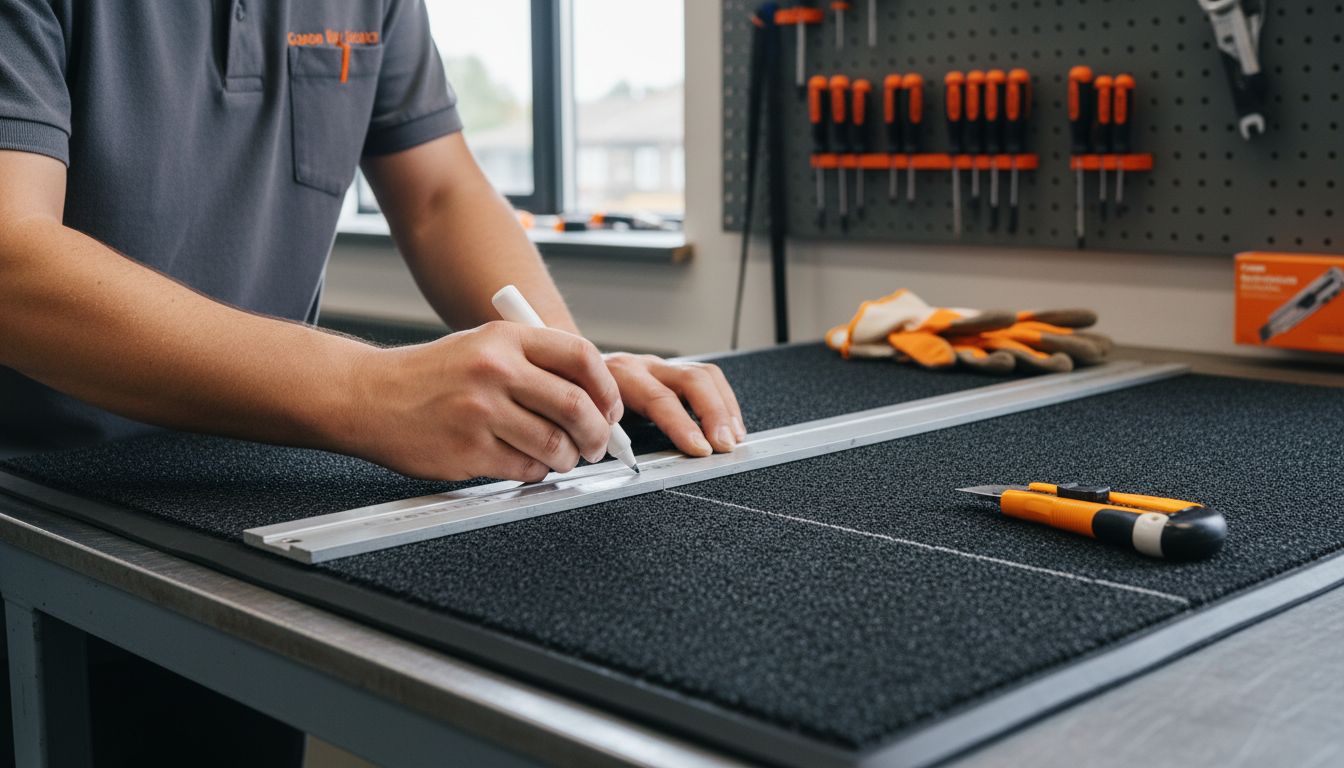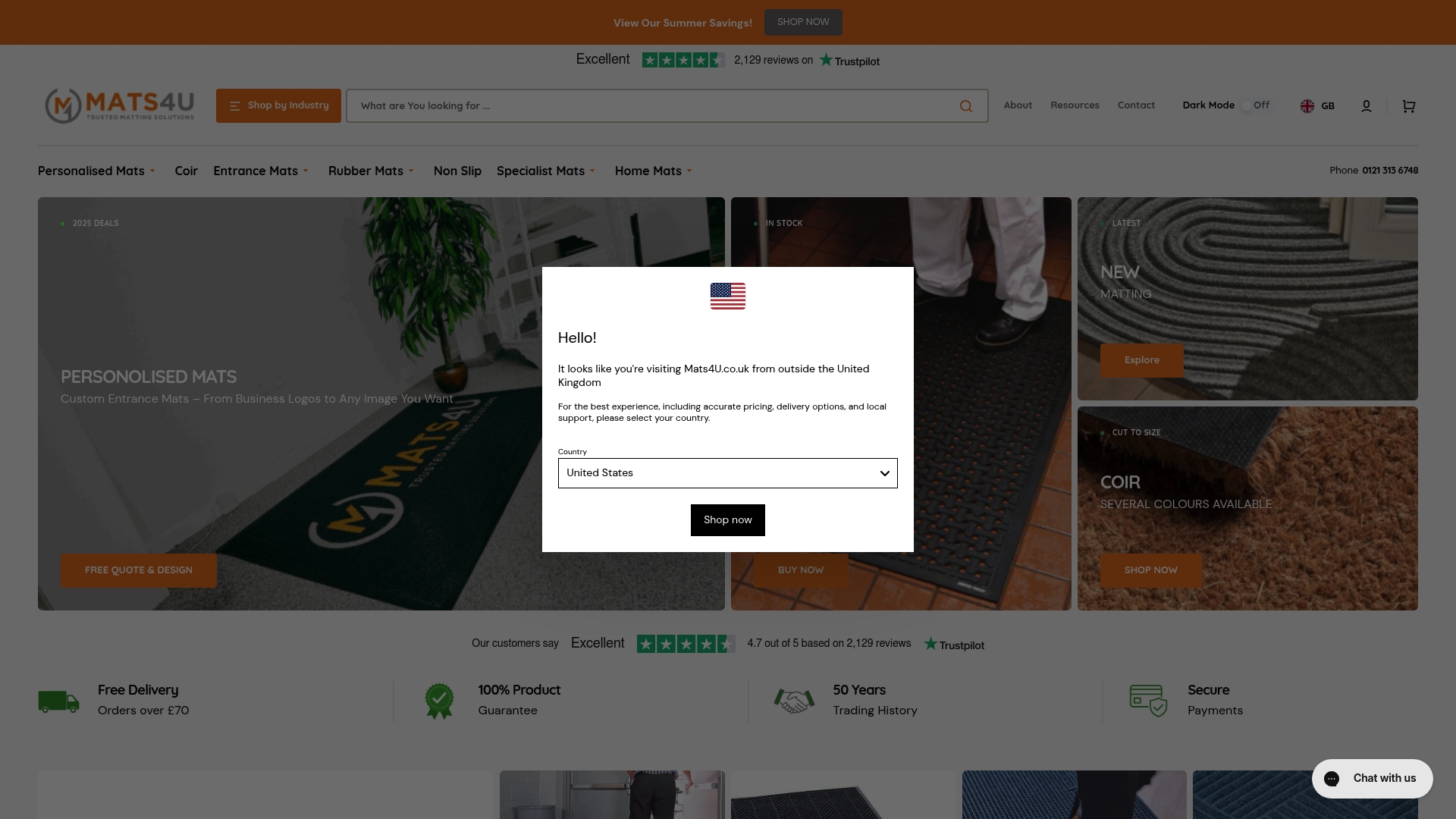Over 80 percent of dirt and moisture in commercial spaces comes from foot traffic passing through the entrance. A well-chosen front door mat is more than a welcome mat, it is your first defence against hazards and costly cleaning bills. Choosing and installing the right mat may seem simple, yet small mistakes can impact safety and your business image. Learn how each step, from measuring to precise trimming, sets the stage for a safer, cleaner, and more professional entrance.
Table of Contents
- Step 1: Assess Entrance And Measure Mat Requirements
- Step 2: Select Appropriate Mat Material For Your Facility
- Step 3: Mark Cutting Lines And Prepare Work Area
- Step 4: Trim Mat Precisely To Measured Dimensions
- Step 5: Test Fit And Verify Mat Placement
Quick Summary
| Key Point | Explanation |
|---|---|
| 1. Measure Entrance Accurately | Ensure your mat covers the entire doorway and extends one metre on each side for optimal dirt trapping and safety. |
| 2. Choose Suitable Mat Material | Select materials like nylon for indoor areas and nitrile rubber for industrial settings to maximize durability and functionality. |
| 3. Prepare Work Area Thoroughly | Clear and clean your workspace to ensure precise cutting and high-quality installation of your custom mat. |
| 4. Trim Mat with Precision | Use proper cutting techniques and tools to create clean, straight edges for a professional appearance and safety. |
| 5. Verify Mat Placement | Test the mat in various scenarios to ensure it fits well, allowing easy pedestrian and wheelchair access while minimizing hazards. |
Step 1: Assess Entrance and Measure Mat Requirements
You are about to master the critical first step in selecting the perfect front door mat for your business: precise measurement and strategic assessment. Understanding your entrance requirements will ensure you choose a mat that maximises cleanliness, safety, and professional appearance.
Begin by thoroughly examining your entrance area. According to the British Standard BS 7953, your entrance matting should span the full width of the door opening with an optimal length of 3 to 5 metres for normal dirt pick up. For high traffic commercial spaces, you might need up to 6 to 7 metres of matting to effectively trap dirt and moisture.
Measure your entrance width first. Ensure the mat covers the entire doorway with an additional extension of at least one metre on each side. This allows for different entry angles and accommodates various foot traffic patterns. Pay special attention to wheelchair accessibility too.
Pro Tip: Always measure twice and order once. A precise measurement prevents costly mistakes and ensures your custom mat fits perfectly.
Consider your specific traffic patterns. A corporate lobby will have different matting needs compared to a retail entrance or industrial facility. Observe how people move through the space track dirt entry points and choose your mat dimensions accordingly.
In the definitive guide to entrance mats, we explore how strategic matting can dramatically reduce cleaning costs and improve workplace safety. Precise measurement is your first step towards achieving these goals.
Step 2: Select Appropriate Mat Material for Your Facility
Choosing the right mat material is crucial for ensuring durability, functionality, and performance in your specific business environment. Your selection will directly impact cleanliness, safety, and long-term maintenance costs.
As research from industry experts indicates, different materials excel in different scenarios. Textile materials like nylon and polypropylene are exceptional choices for high-traffic areas. These fabrics offer remarkable crush resistance and outstanding stain and fade resistance, making them ideal for corporate lobbies, retail spaces, and busy commercial entrances.
For exterior and heavy-duty applications, nitrile rubber mats stand out. These robust materials provide excellent dirt-scraping performance and can withstand harsh weather conditions and constant foot traffic. They are particularly suitable for industrial settings, warehouses, and outdoor commercial entrances where durability is paramount.
Pro Tip: Consider your specific environment when selecting mat materials. A material perfect for a retail space might not perform equally well in an industrial setting.
Natural materials like coir mats present interesting options but come with limitations. Derived from coconut shells, these mats have a distinctive bristled appearance. However, they are slow-drying and prone to staining, which makes them less practical for most commercial environments.
In our ultimate guide to dust control mats, we explore how material selection can dramatically improve workplace hygiene and safety. Your mat is not just a floor covering it is a critical first line of defence against dirt, moisture, and potential workplace hazards.
Here’s a comparison of popular entrance mat materials and their ideal applications:
| Material | Best For | Key Benefits | Limitations |
|---|---|---|---|
| Nylon | High-traffic interiors | Crush resistant Stain resistant |
Higher cost |
| Polypropylene | Retail/corporate lobbies | Durable Fade resistant |
Moderate absorbency |
| Nitrile Rubber | Industrial/outdoor use | Heavy-duty Weatherproof |
Less attractive indoors |
| Coir | Traditional entrances | Natural look Eco-friendly |
Slow drying Stains easily |
Step 3: Mark Cutting Lines and Prepare Work Area
Precision is key when preparing to cut your custom entrance mat. This step will ensure a perfect fit that meets professional standards and maximises the mat’s performance in your facility.
According to British Standard 7953, your mat should span the full width of the door opening with a recommended extension of at least one metre on each side. Begin by clearing your work area completely. Remove any obstacles, clean the surface thoroughly, and ensure you have a flat stable workspace with ample room to manoeuvre.
Measure your entrance width meticulously. Use a reliable measuring tape and mark your cutting lines with a chalk or washable marker. Verify your measurements twice the golden rule of precision work.
 When marking lines, ensure they are straight and align perfectly with your initial entrance measurements.
When marking lines, ensure they are straight and align perfectly with your initial entrance measurements.
Pro Tip: Invest in a sharp utility knife and a sturdy cutting mat. Uneven or dull cutting tools can compromise the mat’s edge quality and overall appearance.
If working with rubber or textile mats, consider the material’s thickness and potential compression. Always leave a slight margin for potential minor adjustments. This approach ensures your mat will fit seamlessly and function optimally in your specific environment.
In our indispensable guide to wet area mats, we explore how precise preparation can significantly enhance workplace safety and efficiency. Careful marking and preparation are your first steps towards a professional installation.
Step 4: Trim Mat Precisely to Measured Dimensions
Now comes the most critical stage of your custom mat installation: precise trimming that transforms your measurements into a perfectly fitted entrance solution. Your careful cutting will ensure safety, functionality, and a professional appearance.
Research indicates that permanent fitted entrance mats installed flush to the floor significantly reduce trip hazards and meet essential safety regulations. Begin by double checking your marked cutting lines. Position your mat on a sturdy cutting surface with a protective mat underneath to prevent damaging your work surface.
Use a metal straightedge as a cutting guide to ensure absolutely straight lines. Apply consistent pressure with your utility knife, making multiple gentle passes rather than attempting to cut through in a single aggressive stroke. This technique provides cleaner edges and greater control over your cut.
Pro Tip: Always cut away from your body and wear protective gloves. A moment of caution prevents potential accidents.
According to industry guidelines, your mat should extend at least one metre on each side of the door opening to accommodate various entry angles. This approach ensures thorough dirt and moisture removal for both foot and wheeled traffic. Take your time and make each cut deliberate and precise.
In our ultimate guide to non slip rubber kitchen mats, we explore how precision in mat installation contributes to workplace safety. Your careful trimming is more than a technical step it is an investment in your facility’s professional standards.
Step 5: Test Fit and Verify Mat Placement
With your custom mat carefully trimmed, the final crucial step is ensuring its perfect placement and functionality. This verification process will guarantee your investment meets safety standards and performs optimally in your specific environment.
According to industry experts, entrance matting should span the full width of the door opening with an extension of at least one metre on each side. Carefully lay your newly cut mat in the designated area, checking that it completely covers the entrance while allowing smooth pedestrian and wheeled traffic flow. Look for any gaps, uneven edges, or potential tripping points.
Simulate different traffic scenarios. Walk across the mat from multiple angles, test wheelchair accessibility, and observe how it manages foot traffic. Loose lay mats offer flexibility, allowing you to adjust placement quickly if the initial positioning does not meet your precise requirements.
Pro Tip: Observe the mat during peak traffic times. A perfect fit during a quiet moment might reveal challenges during busier periods.
Ensure the mat sits flush with the surrounding floor surface. Any raised edges or uneven positioning can create slip hazards or compromise the mat’s dirt trapping capabilities. Take time to make minor adjustments that can significantly improve overall performance and safety.
In our definitive guide to entrance mats, we explore how precise placement contributes to workplace hygiene and safety. Your meticulous verification is the final step in creating a professional, functional entrance solution.
Achieve the Perfect Fit with Custom Front Door Mats from Mats4U
Selecting a front door mat cut to size is essential for businesses aiming to enhance cleanliness, safety and aesthetic appeal at their entrance. You understand the challenge of precise measurement and material choice to master high traffic and varied foot traffic patterns. With key concepts like extending matting beyond the doorway and selecting crush resistant or weatherproof materials, the process can feel complex yet critical.
At Mats4U, we specialise in solving these exact challenges by offering a wide range of tailor-made entrance mats. Whether you need durable textile options or heavy-duty rubber solutions, our Front Back Door Mats category has been crafted to meet your bespoke requirements. Experience the confidence of a professionally fitted mat that reduces workplace hazards and controls dirt and moisture efficiently.

Secure your business entrance’s first line of defence today by choosing a custom-fit mat from Mats4U. Browse our selection, customise your mat dimensions, and enjoy free UK delivery so your facility can benefit from enhanced safety and lasting cleanliness right away. Explore more about industry-focused mats on our Home Mats | Cloakroom Mats | Speciality Mats page for versatile solutions tailored to your environment.
Frequently Asked Questions
How do I measure my entrance for a custom-fit door mat?
To measure your entrance for a custom-fit door mat, start by measuring the width of the door opening and ensure the mat extends at least one metre on each side. For optimal dirt pickup, consider a mat length of 3 to 5 metres for normal traffic or 6 to 7 metres for high-traffic areas.
What material should I choose for my entrance mat?
Select a mat material based on your specific traffic and environmental needs. For high-traffic areas, nylon or polypropylene are ideal, while nitrile rubber is recommended for outdoor or industrial settings. Assess the conditions of your facility to determine the best fit.
How should I prepare the work area before cutting my custom mat?
Clear your work area completely, ensuring it is flat and stable. Remove any obstacles and clean the surface before marking your cutting lines to ensure a precise cut that suits your entrance dimensions.
What is the best way to trim a door mat to size?
Use a sharp utility knife and a metal straightedge to guide your cut for straight edges. Make several gentle passes rather than cutting through in a single stroke, which will help achieve cleaner edges and better control over your cuts.
How do I verify the fit of my custom door mat?
Carefully place your newly trimmed mat at the entrance and check that it covers the entire opening while allowing for smooth traffic flow. Walk across the mat from different angles to identify any gaps or edges that may need further adjustment.
What are the safety considerations when installing a door mat?
Ensure that the mat lies flat and flush with the surrounding floor to avoid trip hazards. Check for any raised edges or uneven surfaces, and make adjustments as necessary to maintain safe and efficient foot traffic.
Recommended
- Complete Guide to the Importance of First Impressions – Mats4U
- Elevate Your Entrance: The Ultimate Guide to Premium Rust Coir Doormat – Mats4U
- An Entrance Mat: A Year-Round Strategic Asset, Not Just for Winter – Mats4U
- How to Create Custom PPF Patterns Using Aeoncut: Step-by-Step Guide – AEONCUT PPF Pre-cut Cutting software
- Shop Fascia Design Tips for London Businesses 2025 - PromoSigns.co.uk









